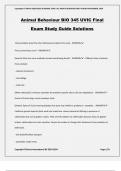Exam (elaborations)
Animal Behaviour BIO 345 UVIC Final Exam Study Guide Solutions
Institution
2025 Prep Tests
Animal Behaviour BIO 345 UVIC Final
Exam Study Guide Solutions
Draw predator-prey flow chart (behavioural options for prey) - ANSWER-
Prey survivorship curve? - ANSWER-
(Search) What are some methods animals avoid being found? - ANSWER-- Different time of activity
from predator.
- reduced mov...
[Show more]
Preview 4 out of 31 pages
Uploaded on
November 3, 2024
Number of pages
31
Written in
2024/2025
Type
Exam (elaborations)
Contains
Questions & answers
Institution
2025 Prep Tests
Course
2025 Prep Tests
$13.49
100% satisfaction guarantee
Immediately available after payment
Both online and in PDF
No strings attached
Copyright © KAYLIN 2024/2025 ACADEMIC YEAR. ALL RIGHTS RESERVED FIRST PUBLISH NOVEMBER, 2024




